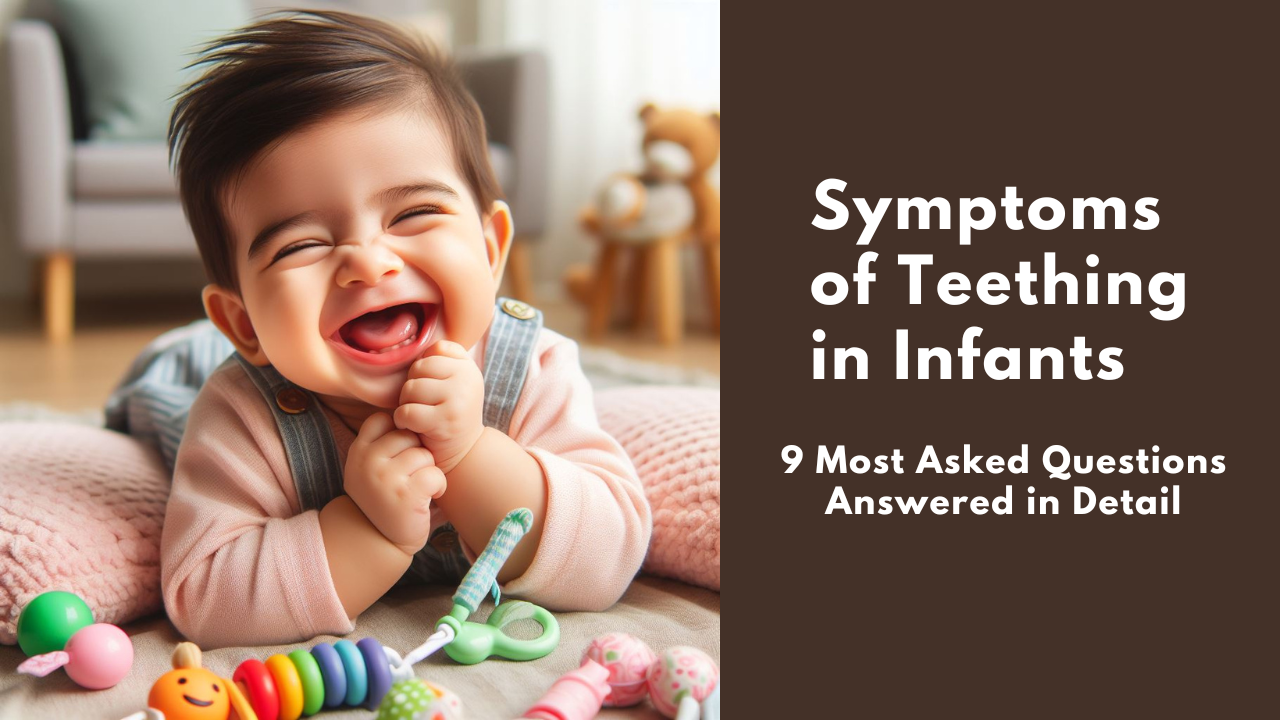
Teething is a natural process that every infant goes through, but it can be a challenging time for both the baby and the parents. As a parent, it’s important to know what to expect when your baby starts teething and how to soothe their discomfort. In this article, we will answer the 9 most frequently asked questions about symptoms of teething in infants, including: when does teething start, what are the signs and symptoms of teething, how long does teething last, what is the order of tooth eruption, and what are some remedies to soothe a teething baby. We will also provide you with some interesting facts about baby teeth that you may not know. So, let’s dive in and learn more about teething in infants!.
Table of Contents
1. When do infants typically start teething?
Typically, most infants start teething around 6 months of age. However, it’s important to remember that every baby is different, and the timing of teething can vary significantly:
- Early Teethers: Some babies can sprout their first teeth as early as 3 months old, or even in newborns, although this is relatively rare.
- Late Bloomers: Other babies might not show any signs of teething until closer to 12 months old or even later.
Here’s a breakdown of the general timeframe:
- 3-6 months: Increased drooling, chewing on hands, and fussiness might be early signs.
- 6-12 months: Lower central incisors (front bottom teeth) typically appear first, followed by upper central incisors.
- 10-24 months: Lateral incisors (teeth next to the front ones) and first molars (back teeth) emerge.
- 18-31 months: Sharp canine teeth (between incisors and molars) erupt, followed by the second molars.
Remember, individual variations are common and don’t worry if your baby’s timeline doesn’t align exactly with this range. Here are some additional factors that can influence the timing of teething:
- Genetics: Family history can play a role, with babies whose parents teethed early sometimes following suit.
- Birth weight: Larger babies might tend to teeth slightly earlier than smaller babies.
- Nutrition: Breastfed babies might experience slightly delayed teething compared to formula-fed babies.
2. What are the most common symptoms of teething in infants?
Here are some of the most common symptoms of teething in infants:
1. Excessive Drooling
This is arguably the most common sign of teething. As the teeth push through the gums, they stimulate the salivary glands, leading to an increase in saliva production. This drool can cause drool rash around the mouth and chin, so keep bibs handy and gently pat the drool with a soft cloth to prevent irritation.

2. Chewing on Everything
Babies with sore gums will often chew on anything they can get their hands on, including fingers, toys, and even furniture. This is their way of trying to relieve the pressure and discomfort. Offer safe teethers made of rubber or silicone for them to gnaw on.

3. Crankiness and Fussiness
Teething can be painful and irritating, so it’s no surprise that many babies become cranky and fussy during this time. They may cry more than usual, have difficulty sleeping, and seem generally out of sorts.
4. Swollen and Tender Gums
Take a peek inside your baby’s mouth! You might see red, swollen gums where the teeth are about to break through. Gently massage the gums with a clean finger or a damp washcloth to provide some relief.
5. Changes in Eating Habits
Some babies may lose their appetite or become more picky eaters during teething. This is because chewing can be uncomfortable, and they may simply not feel like eating as much. Offer soft, mashed foods that are easier to swallow.
6. Mild Fever
A slight temperature increase (less than 101°F or 38°C) is occasionally associated with teething. However, a high fever exceeding 102°F or lasting more than 3 days requires medical attention.
7. Diarrhea
While mild, loose stools can sometimes occur during teething, persistent or severe diarrhea is not a typical symptom and could indicate another issue. Consult your doctor if your baby has diarrhea lasting more than 24 hours.
8. Earache
The trigeminal nerve, which supplies sensation to the gums and face, also branches to the ear. This means that teething discomfort can sometimes be felt in the ear, leading to fussiness and pulling at the ear.
9. Sleep Disruptions
The pain and discomfort of teething can make it difficult for babies to sleep soundly. They may wake up more frequently, cry out in the night, or seem restless.
10. Chewing Cheeks
Remember, every baby is different, and they may experience all, some, or none of these symptoms. If you’re concerned about your baby’s teething or if they have any severe or persistent symptoms, be sure to consult your doctor.
3. How long does the teething process usually last in infants?
The First Phase
- 0-6 months: Babies usually don’t show any outward signs of teething during this period. However, some may experience increased drooling and chewing as early as 3 months.
- 6-12 months: This is when the first teeth, typically the lower and upper central incisors, begin to erupt. Expect increased drooling, gum rubbing, crankiness, and possibly mild fever (less than 101°F). This phase can last several weeks for each tooth.
The Ongoing Journey
- 12-24 months: More teeth start popping up in succession, including lateral incisors, first molars, and canines. The same symptoms as the first phase might recur for each tooth, with the duration varying between weeks and months.
- 24-33 months: The second molars finally arrive, completing the set of 20 primary teeth. By this point, most babies have adapted to the teething process, although occasional discomfort around new teeth is still possible.
These are just general timelines, and individual variations are common. Some babies might start teething earlier, while others might not show signs until closer to a year old.
4. Does teething cause fever in infants?
Teething can cause a slight temperature rise in infants, but high fever is not a typical symptom and requires further investigation.
Here’s a breakdown of the relationship between teething and fever:
- Mild Temperature Rise: A slight increase in body temperature (less than 101°F or 38°C) might accompany teething and is usually temporary, lasting a day or two. This slight fever is likely due to the body’s inflammatory response as teeth push through the gums.
- High Fever: A temperature exceeding 102°F (38.9°C) or a fever lasting more than 3 days is not characteristic of teething and suggests a potential underlying illness. It’s crucial to seek medical attention if your baby has a high fever along with teething.
Causes of High Fever During Teething
- Viral or bacterial infections (ear infections, common cold)
- Urinary tract infections
- Roseola (viral illness with high fever followed by a rash)
Distinguishing Teething Fever from Illness
- Other symptoms: Alongside fever, look for signs of an illness like cough, congestion, earache, vomiting, diarrhea, or decreased activity.
- Duration and severity: Teething fever is usually mild and short-lived, while fever from illness might be higher and persist longer.
- Baby’s overall well-being: Observe your baby’s behavior. Teething might cause crankiness, but extreme fussiness, lethargy, or difficulty breathing suggest illness.
When to Consult a Doctor
- High fever exceeding 102°F (38.9°C)
- Fever lasting more than 3 days
- Fever accompanied by other concerning symptoms like cough, vomiting, diarrhea, or earache
- Difficulty breathing or swallowing
- Any other concerns about your baby’s well-being
Remember that teething doesn’t always cause fever, and if your baby does have a fever, it’s important to rule out other potential causes. Don’t hesitate to consult your doctor if you have any concerns about your baby’s health during teething or at any other time.
5. Is diarrhea a common symptom of teething?
No, diarrhea is not a common symptom of teething in infants. While mild loose stools may occasionally occur during this phase, persistent or severe diarrhea is not typically associated with teething and could be a sign of an underlying issue.
How to distinguish between teething and other causes of diarrhea?
- Teething diarrhea: It’s usually mild and short-lived. Other classic teething symptoms like drooling, gum swelling, and irritability are also present.
- Other causes of diarrhea: Viral or bacterial infections, food allergies, and lactose intolerance can also cause diarrhea in infants. These conditions often present with additional symptoms like fever, vomiting, and changes in appetite.
When to seek medical attention?
- If your baby has persistent or severe diarrhea (lasting more than 24 hours)
- Diarrhea is accompanied by other concerning symptoms such as fever, vomiting, blood in the stool, or dehydration (dry mouth, sunken eyes, decreased urination).
6. Is it normal for my baby to drool excessively during teething?
Yes! Excessive drooling is one of the most common and telltale symptom of teething in infants. As those first teeth break through the gums, your baby’s salivary glands go into overdrive, producing much more saliva than usual.
How drooling helps?
This increased saliva flow serves several important purposes:
- Soothes and numbs inflamed gums: The extra saliva acts like a natural lubricant, easing the pressure and discomfort caused by erupting teeth.
- Helps clean the mouth: As teeth emerge, they attract food particles and bacteria. The increased saliva helps wash away these potential irritants, promoting oral hygiene.
- Aids in digestion: Saliva contains enzymes that help break down food. The extra saliva during teething can contribute to better digestion, especially for babies who are starting to eat solid foods.
While the sight of a drooling baby might be amusing, excessive drooling can be bothersome for your little one. It can lead to drool rash around the mouth, chin, and neck, causing red, bumpy skin.
Ways to manage drooling
Here are some ways to help manage drool and soothe your baby’s discomfort:
- Keep bibs handy: Use absorbent bibs to catch the drool and protect your baby’s clothes. Change them frequently to prevent skin irritation.
- Gentle cleaning: Gently pat the drool with a soft, dry cloth to prevent drool rash. Apply moisturizing cream to soothe any irritated skin.
- Chilled teethers: Offer safe, chilled teethers for your baby to gnaw on. The coolness can help numb irritated gums and distract them from the drool.
7. Can teething lead to disruptions in my baby's sleep patterns?
Unfortunately, yes, teething can often lead to disruptions in your baby’s sleep patterns.
Why teething can disturb sleep?
- Gum discomfort: The pressure and inflammation caused by erupting teeth can be quite painful, making it difficult for your baby to settle and stay asleep.
- Increased drooling: The extra saliva production associated with teething can make your baby feel uncomfortable and even lead to coughing or choking sensations that wake them up.
- Cranky mood: Discomfort and pain can make babies irritable and more prone to waking up crying or fussing.
- Changes in feeding: Some babies might nurse or drink more frequently during the night due to gum sensitivity or the desire for comfort.
How can you help your teething baby sleep better?
- Soothing routines: Implement calming bedtime routines, including baths, massages, and quiet stories, to help your baby unwind and associate bedtime with relaxation.
- Offer teethers: Provide safe, chilled teethers that your baby can gnaw on to relieve gum discomfort.
- Gum massage: Gently massage your baby’s gums with a clean finger or damp washcloth.
- Adjust feeding: Consider offering smaller, more frequent feedings throughout the night instead of large meals to minimize stomach discomfort.
- Stay calm and patient: While frustrating, remember that teething is temporary. Offer comfort, cuddles, and reassurance to help your baby through the rough nights.
- Adjust sleeping arrangements: Consider co-sleeping safely or placing your baby’s crib close to yours for easier soothing and comfort.
Things to keep in mind
- Every baby is different, and what works for one might not work for another. Experiment with different techniques and find what offers your little one the most comfort and sleep.
- Don’t introduce new sleep training methods during teething, as this can add further stress and confusion.
- Consult your doctor if the sleep disruptions are severe, persistent, or accompanied by other concerning symptoms like fever, diarrhea, or earache.
8. How can I soothe my teething baby's discomfort?
Fortunately, there are plenty of ways to soothe your little one’s discomfort and make this phase a little less bumpy. Here are some tactics you can try:
Teething Toys and Tools
- Chilled Teethers: Offer textured teethers chilled in the refrigerator (not the freezer) for safe gnawing and pressure relief.
- Mesh Feeders: Frozen fruit or frozen breast milk in mesh feeders provide relief while offering additional nutrients.
- Cool Washcloths: Chilled washcloths provide soothing coolness to inflamed gums.
- Gum Massage: Gently massage your baby’s gums with a clean finger or damp washcloth.
Natural Comfort and Relief
- Cold Liquids: Offer chilled water, breast milk, or formula to numb the gums and prevent dehydration.
- Cuddles and Calming Environment: Close contact, rocking, singing, and creating a calm atmosphere can ease anxiety and provide comfort.
- Distraction and Activities: Offer engaging toys or books. Divert attention from discomfort with interesting sights and sounds.
- Change feeding positions: Different breastfeeding or bottle-feeding positions might improve comfort while your baby chews.
Additional Tips
- Avoid amber necklaces: Despite claims, amber necklaces are not recommended for teething relief due to choking hazards and lack of scientific evidence for their effectiveness.
- Track symptoms: Keep a diary to monitor the progression and intensity of your baby’s symptoms. This helps you identify potential concerns and discuss them with your doctor.
- Stay calm and patient: Remember, teething is temporary. Offer plenty of affection, understanding, and comfort to help your little one through this phase.
9. What should I do if my baby's teething symptoms seem severe?
When your baby’s teething symptoms seem severe, it’s understandable to feel worried and unsure how to proceed. Here are some steps you can take:
Assess the severity and duration of symptoms
- High fever: Anything exceeding 102°F or a fever lasting more than 3 days warrants immediate medical attention.
- Persistent diarrhea or vomiting: Diarrhea lasting more than 24 hours, severe vomiting, or blood in the stool requires consulting a doctor.
- Extreme crankiness and lack of sleep: Teething discomfort is normal, but inconsolable crying, difficulty sleeping for extended periods, or significant changes in personality could indicate additional issues.
- Difficulty breathing or swallowing: These are emergency signs requiring immediate medical attention.
Implement soothing strategies
- Offer chilled teethers: Choose safe, textured teethers and chill them in the refrigerator, not the freezer.
- Gently massage their gums: Use a clean finger or wet washcloth to provide pressure and relief.
- Cool liquids and soft foods: Offer chilled water or breast milk/formula to soothe gums and prevent dehydration. Consider softer foods if chewing is uncomfortable.
- Over-the-counter pain relievers: Consult your doctor about age-appropriate and safe pain relievers.
Consult your doctor
If any of the “severe symptom” red flags are present, don’t hesitate to seek immediate medical attention.
If you’re concerned about the intensity or duration of your baby’s teething symptoms, even in the absence of red flags, consulting your doctor is always the best course of action. They can assess your baby, provide individualized advice, and rule out any underlying conditions.
Stay calm and be patient
Conclusion
Teething is a natural and gradual process. While most symptoms are relatively mild and temporary, they can cause discomfort for infants. Every baby is different, so their response to teething symptoms may vary. Being observant and providing comfort measures can help ease their discomfort during this developmental phase.
Please note: Always consult a pediatrician or healthcare provider for personalized advice regarding your baby’s health and any concerns related to teething or other health issues.
Bonus: Interesting facts about baby teeth
- Tooth buds begin developing in the fetus as early as six weeks into pregnancy.
- Babies are usually born with 20 primary teeth that are hidden under the gums.
- The first tooth typically emerges between 4 to 7 months, often the lower central incisors.
- By age 3, most children have a full set of primary teeth.
- Baby teeth help in speech development, proper nutrition, and guide the permanent teeth into place.
- Losing baby teeth usually starts around age 6 and continues until the age of 12 or 13.
- Tooth decay can affect baby teeth; therefore, dental care should begin early.
- Baby teeth contain stem cells, which could be preserved for future medical treatments.
- Each child’s tooth eruption and shedding timeline can differ significantly.
